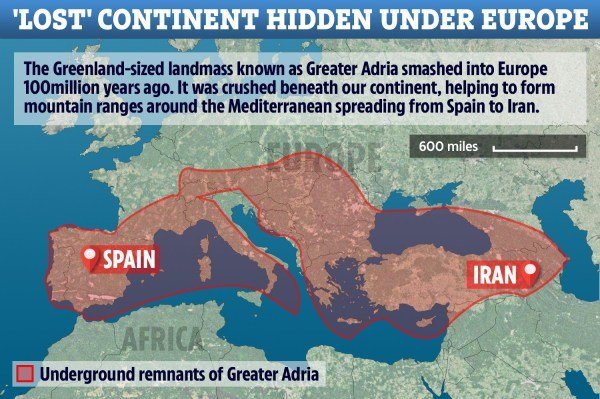A missing piece of North Africa, which has been hidden for 140 million years under Europe, has been discovered by scientists.
The research can be found in this month’s publication of the Gondwana Research journal titled ‘Orogenic architecture of the Mediterranean region and kinematic reconstruction of its tectonic evolution since the Triassic.’
The buried continent was discovered when researchers set out to reconstruct the complex geological evolution of the Mediterranean. They found a piece of continental crust, the size of Greenland, that was detached from North Africa and plummeted into the Earth’s layer under southern Europe.

“Most mountain chains that we investigated originated from a single continent that separated from North Africa more than 200 million years ago. The only remaining part of this continent is a strip that runs from Turin via the Adriatic Sea to the heel of the boot that forms Italy,” Douwe van Hinsbergen, study author and professor of global tectonics and paleogeography at Utrecht University, told CNN.
The area where the continent is hidden is called Adria so the undiscovered continent is referred to as “Greater Adria” by its founders at Utrecht University in the Netherlands.
While most of the continent is underwater, much of the land mass’s alluvial pieces wore off during its great migration. Those scrapings are today’s European mountain belts, including parts of the Alps, Greece and Turkey.
Most holidaymakers, who travel to the Mediterranean region, might have stepped on the last traces of the Greater Adria without knowing, particularly those that enjoy the mountainous sceneries of Italy, Turkey, Greece or Croatia.
“Forget Atlantis, without realizing it, vast numbers of tourists spend their holiday each year on the lost continent of Greater Adria,” Douwe said.
To gather information that covers the Mediterranean’s vast and complex region, the researchers had to engage scientists and researchers from 30 countries, inculcating their already existing research consisting of “surveys, maps and pre-existing ideas about how things formed” into the study.
Geologists refer to the Mediterranean area as a geological mess. “It is quite simply a geological mess: Everything is curved, broken and stacked,” said van Hinsbergen.
“Compared to this, the Himalayas, for example, represent a rather simple system. There you can follow several large fault lines across a distance of more than 2,000 kilometers.”
Scientists rebuilt the continent’s size and shape with sophisticated plate tectonic reconstruction software. They used “thousands of pieces of information” about fault lines, stored magnetism in rocks and other Earth movements to produce the final image.
According to the lead researcher, Van Hinsbergen, the visible parts of the newly discovered continent can be seen in Southern Europe’s mountain ranges.
“The rest of the piece of continental plate, which was about 100 km thick, plunged under Southern Europe into the Earth’s mantle, where we can still trace it with seismic waves up to a depth of 1500 km.”










